For much of the past decade, the Air Force employed a concept termed “reachback.” A commander in the field would “reach back”—electronically, of course—to US-based offices for vital information. This entailed tapping Stateside intelligence experts thousands of miles from a war zone.
Simply put, intelligence-surveillance-reconnaissance (ISR) aircraft in the battlespace would transmit data to these US-based analysts. They would exploit the data, send their interpretation back to the theater, and stand by for commander inquiries.
That was then. Today, cyber networks, lightning-quick communications systems, and increased bandwidth have pushed those ISR analysts directly into the fight, even though they are still physically half a world away from the war zone.
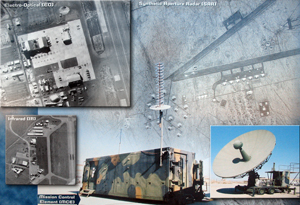 |
Elements of the Global Hawk system and examples of its product on display. |
Reachback began as a logistical tool; it allowed USAF to keep entire units at US bases, eliminating the need to move them and their equipment into a theater and keep them sustained once they were there.
Today, logistics is the least of it. The modern analyst resides, figuratively, at the fingertips of practically any foot soldier, and this change is paying big combat dividends.
The battlefield edge is provided by the Distributed Common Ground System, a series of five interconnected clearinghouses of ISR. In this system, USAF personnel gather data and send it rapidly to where it is needed. They collect feeds from Predators, Reapers, Global Hawks, U-2s, RC-135s, and even the targeting pods on fighters. The DCGS network provides commanders at all levels with the knowledge—and not just the data—needed to win.
DCGS, in the Fight
Col. Kevin B. Wooton, commander of the 548th Intelligence, Surveillance, and Reconnaisance Group at Beale AFB, Calif., is in charge of Distributed Ground System-2, one of the five clearinghouses. Wooton, summing up his view of DCGS, said, “This is a weapon system.”
Each distributed ground system (DGS) looks much like an air operations center. In a large, darkened room, banks of computer terminals with multiple screens are crewed by dozens of military personnel. Some are watching video feeds, others maps, some are talking into headsets, and still others are typing in Internet chat rooms.
Sometimes, they pass along raw information. At other times, they perform and transmit “value added” analysis, meaning they connect the dots and assemble the big picture for a commander.
Wooton maintains that his DGS technicians are very much “in the fight.” They must train for their jobs to learn how to interpret imagery; how to talk to other parts of the US military; proper procedure for issuing and taking requests for information; when to skip regular channels and go right to the user; and how to alert ground forces to danger. They must observe crew rest periods and take “check rides.”
The outside of their facilities bears squadron insignia and mission markings to denote their contributions and successes.
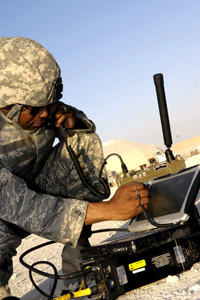 |
MSgt. Chris Thompson, a joint terminal attack controller, communicates using a ROVER in Southwest Asia. |
The Glue Is DCGS
“The strength of Air Force ISR is the systems working together,” Wooton explained. “Sometimes, all people need is … to look over that next hill. We have a lot of capability to do that.”
The DGS will often pipe data directly to troops on the ground. That, however, is merely using the formidable ISR network as high-tech binoculars, Wooton said.
“If you want to start developing intelligence, where a commander can make some kind of a decision to take out an enemy,” analysis and fusion are needed.
“The glue holding it all together is the DGS,” he said.
Wooton’s DGS-2 has traditionally processed, exploited, and disseminated the intelligence products of the U-2 spyplane and, more recently, the RQ-4 Global Hawk recce drone. He works for US Southern Command, and the long-legged U-2s and Global Hawks at Beale sometimes undertake direct ISR missions to South America.
US Air Forces Central is supported by DGS-1 at Langley AFB, Va. DGS-3 is at Osan AB, South Korea, and supports forces on the peninsula there; DGS-4 at Ramstein AB, Germany, supports US Air Forces in Europe; and DGS-5, supporting Pacific Air Forces, is located at Hickam AFB, Hawaii.
All of the DGS locations are interconnected and, in many ways, function as a single entity. The analysts in each location are mere seconds away from each other by voice or chat. Sometimes, the most expedient way to answer a question is to roll a chair two stations away and ask the expert.
“The fastest way we have of getting information [to a user] is voice or a chat room. Most of the day-to-day intel is passed by chat,” Wooton noted.
The chat rooms allow everyone with a stake in a particular area, mission, or even an individual being watched to quickly communicate what they have, what they need, and how they can make things go more smoothly.
In the “room” will often be a joint terminal air controller (JTAC), connected by his field laptop, as well as the air operations center and other interested parties. Pilots of U-2s or crew on RC-135s can also participate by voice.
“It is a discussion led by commanders,” Wooton explained. “It’s not multiple hierarchies that force you to wait” for approval or clearance. The organization is flat—deliberately so—to get information where it needs to go, fast.
In a Predator mission, for example, Wooton said the chat room will be populated by representatives of Nellis AFB, Nev., the JTAC, the combined air operations center (CAOC), the DGS, and various intelligence organizations.
“If we have to keep certain people out, those things can be password-protected,” he noted. “We do work with [special operations forces] and protect their data differently.”
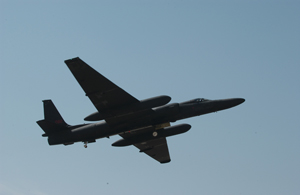 |
A U-2 spyplane makes a high speed takeoff. |
The chat method has vastly sped up the process of taking and answering requests, Wooton noted, and has almost eliminated “playing telephone” in which one person is told to tell another to tell another, etc. The most direct communications are used.
“When I’m telling a sergeant, I’m simultaneously telling his entire chain of command in a chat room,” Wooton noted. But it would be wrong to think of those other recipients as merely being copied on a message.
Wooton waved off such a notion as “linear think.” Rather, “everyone gets the same information at the same time.” Moreover, it’s not freestyle conversation. There are strict rules developed by US Central Command over the years, and “chat room discipline.”
Requests for data filter through the DGS system. Frequently, an answer is already in the database. Sometimes, a mission is already under way to collect the needed data. If not, an aircraft in flight may be diverted to get the answers.
Real Value Added
In the current fights, tactics, techniques, and procedures are developed “on the fly,” Wooton said, because the capabilities of new systems such as the Global Hawk and Reaper are still being discovered. With battle experience, though, DGS personnel are learning how to “focus” the array of sensor aircraft and create a long-term view, which is the real “value added” of the system, he said.
When a request comes in from the field, experts at the DGS frequently talk directly to commanders or “the guy who needs the information. And [they] make sure we’re answering the right question and that he’s asking the right question.”
To help educate field commanders about what ISR capabilities are available to help them, the DGSs have liaisons who serve at every CAOC and with every ground force division commander. They “help it happen,” Wooton said. “I don’t think we need to sell” anyone on the capabilities anymore.
All this is possible because of new communication links and larger bandwidth. Wooton said that also puts the ultimate subject experts at the fingertips of the commanders.
 |
These U-2 aircraft symbols are mission markers painted on a distributed ground system at Beale. Each airplane represents a single U-2 mission over the Middle East. |
“The term ‘reachback’ is really archaic,” Wooton asserted.
The term is “Cold War mentality. It’s passive.” The term suggests that if a field operator needs information, he knows where to call. The reality of today, though, is “we’re more likely to call them … [or] we’re mostly online with each other as we go, via those liaison officers.”
He offered as an example a recent collaborative effort to warn a convoy of an ambush.
“One of my crews working U-2 received intel from another source [saying] a coalition convoy is going to be attacked. My crews alerted another part of the DGS” that had helped plan a U-2 flight then in the area and they contacted the convoy.
After examining the convoy route, the U-2 was “turned” and collected a radar image of the road ahead. Sure enough, enemies were lying in wait, ready to finish the convoy off after buried mines went off.
“That was not a request [the convoy] made, obviously,” Wooton said, but the fusion of expertise and capability discovered the trap and pushed the warning right to the convoy drivers.
“That convoy had a JTAC who was able to call in B-1s, and we ambushed the ambushers, with 50 enemy killed in action,” Wooton noted. “A very bad day” for the bad guys.
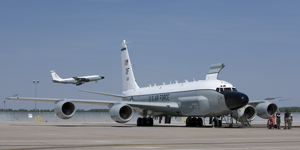 |
Maintainers of the 55th Wing, Offutt AFB, Neb., prep an RC-135W Rivet Joint for a mission. |
He added that “success stories get around. That convoy operation? We work with those guys all the time. They love us.”
Similar episodes are typical, he added. Between 2007 and late 2008, Wooton said, the DGS had participated in 305 “troops in contact” situations “where our guys helped the ground troops. So, nearly one a day.” That total didn’t include 300 confirmed discoveries of improvised explosive devices, or IEDs, and many more that were not confirmed.
If there are many pulls on an ISR platform all at once—the original mission, plus multiple requests from varied operators asking for ISR assistance—the CAOC makes the call as to who gets priority, Wooton said.
“We’re not a rogue operator,” he asserted. It’s the CAOC’s job to set priorities, but it makes the call “in close consultation with the guys on the ground. Nothing is done independently or in a cavalier way.”
Still, it requires discipline in the DGS for all the experts to stay focused on their own missions. When ground troops are in trouble anywhere, it’s apparent to everyone in the DGS, and “everyone wants to help,” Wooton said.
The Art of Interpretation
The 9th Intelligence Squadron, one of six in Wooton’s group, is responsible for processing intel brought in by the U-2 aircraft. The U-2 is unique in being the only high-altitude recce system with cameras that use wet film.
Wooton said the U-2 continues to be a champ in providing solid baseline data for mapping and threat-location purposes. In short, not all urgent requests for ISR data have to be answered with a fresh flyover.
“We are getting very good at, within a couple of hours of a request, going back through old, hard-copy imagery and pulling out” the needed information, Wooton noted. The image is then scanned, digitized, and can be sent to the user “a bunch of ways.” The fastest method is using the network— “assuming you have the bandwidth”—for the extremely high-resolution data. The unit has “some of the largest servers and more digital scanners than anybody else in the world,” Wooton reported.
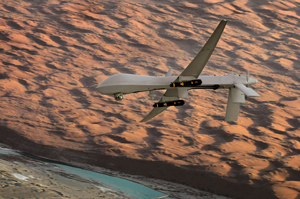 |
An MQ-1 Predator, armed with Hellfire missiles, performs an interdiction and armed reconnaissance mission over Afghanistan. |
However, “when a unit goes downrange, we have the ability to provide them … the latest and greatest mapping of their area.” He added, “We give it to them in a hard drive.”
The 9th Intelligence Squadron is the only unit that works with the large rolls of film, with the exception of a shop in the Defense Intelligence Agency in Washington, D.C. The 9th can deploy its capability, as well.
Gen. John P. Jumper, Air Force Chief of Staff from 2001 to 2005, envisioned that future AOCs would feature a “data wall”: a large digital map of an area of responsibility on which commanders could simply click on an area or a unit and instantly get the most up-to-date information about it, in near-real time, developed automatically by computers. Asked if this device is becoming a reality, Wooton said, “We’re not there, yet.”
He reported that USAF has many of the tools to bring the data wall to fruition, but the process of overlaying optical imagery with radar imagery and determining, for example, if an IED is buried in a particular place still requires a trained analyst.
If such automatic target characterization were attempted today, “you’d be inundated with false calls. You need the trained eye to say, ‘That is man-made.’ We’re at the tool level, but not at an automated level.”
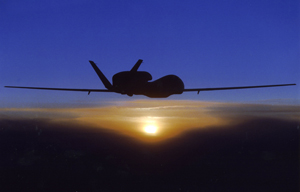 |
An RQ-4 Global Hawk loiters over a target. Such ISR aircraft are being exploited with new USAF systems. |
In fact, the art of studying an area and applying all the available data—temperature, electro-optical images, infrared, microwaves, etc.—is so specialized that Wooton has had to hire former USAF airmen back as consultants for some of the trickier analyses.
If combat winds down rapidly in Iraq and Afghanistan, what would all the analysts do? Wooton said that the expertise that has been developed for the two ongoing fights will likely be useful in any area of interest, and the desire for good, actionable ISR is unlikely to diminish.
New missions also pop up. The Air Force’s ISR aircraft played a significant role in assessing hurricane damage over the last decade, and last year, Wooton said his group was able to provide both ISR sensor data as well as analysis to firefighters battling wildfires in California. Many of the skills involved in assessing combat situations happen to translate well to characterizing a broad area fire and where it’s likely to go next, he noted.
“We were told we saved lives,” he said.
